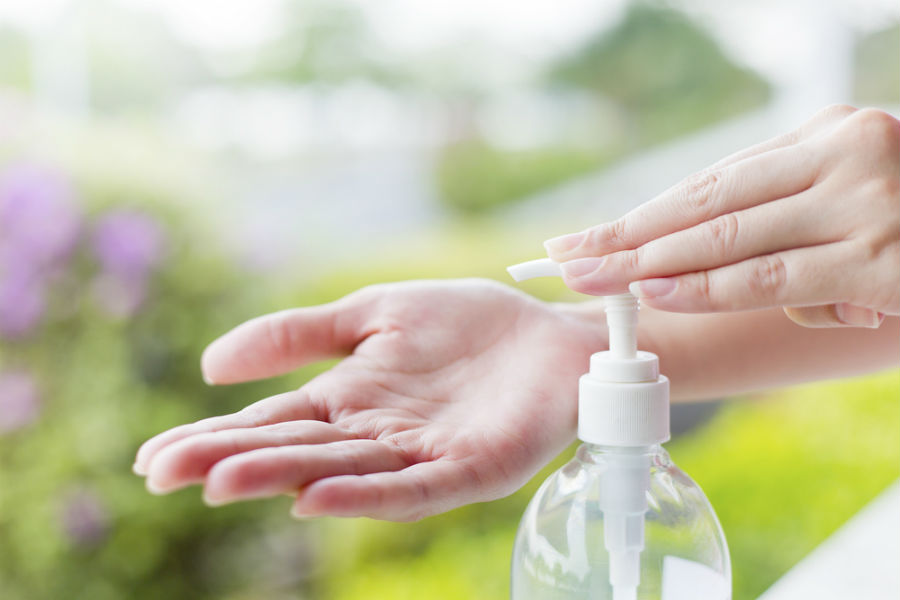Does Hand Sanitizer Work Just as Well as Soap?
COVID-19
•
May 8, 2018

We’ve all been there. You’re out and about, and suddenly, you’re forced to touch something covered in germs, whether it be a dirty shopping cart, a grimy escalator handrail or a sticky handle on the bus. With no sink in sight, you squeeze a dollop of hand sanitizer in your palm and call it good. But is hand sanitizer really as effective as washing your hands with soap and water?
The Short Answer: No
A pump of hand sanitizer should be treated like a backup, not your primary line of defense against pesky germs. Why? Hand sanitizers are simply inadequate in many situations:
- Grubby fingers – If you’ve been playing sports, doing yard work, repairing your car or cooking in the kitchen, hand sanitizer will not disinfect your hands. The layer of grease and grime will prevent the sanitizer from properly cleansing your skin, and you’ll be left with a caked-on mess after applying the gel to your hands.
- Certain germs – Just because certain brands claim to be 99.99 percent effective against germs, doesn’t mean that is necessarily so. For example, hand sanitizer isn’t as good at killing off norovirus, which causes stomach flu and some cases of food poisoning, Cryptosporidium, a tiny parasite that causes diarrhea, and Clostridium difficile, which causes colitis.
- Hazardous substances – If you get some sort of chemical or hazardous substance on your hands, you’ll need to wash them with soap and water and call poison control if it’s an emergency. Applying hand sanitizer does nothing to remove the harmful substance from your skin, which is the main cause of concern.
- Improper application – For hand sanitizer to work as intended, you must apply the right amount, it has to completely cover all surfaces of your hands and it needs to stay on until it dries. If you wipe your palms on your jeans or forget to apply it to the space between your fingers, your hands won’t be as clean as you want!
The Current Hand Sanitizer Debate
Not only are hand sanitizers ineffective in many situations, but they have also recently been subject to increased scrutiny. You may remember the media storm that followed the findings that antibacterial soaps and body washes weren’t any more effective than regular ones. In 2016, the U.S. Food and Drug Administration (FDA) required manufacturers to cease production of consumer antiseptic washes containing 19 active ingredients, including triclosan and triclocarban. The FDA was concerned about possible negative health risks due to overexposure, such as bacterial resistance, which makes germs harder to fight off.
The FDA is now conducting further investigation into the effectiveness and safety of consumer antiseptic rubs, like hand sanitizers. While the regulatory agency doesn’t necessarily believe them to be unsafe, they do want additional information about the contents, particularly the levels of ethanol/ethyl alcohol, isopropyl alcohol, and benzalkonium chloride. The FDA wants to be sure these substances are safe for use by children and pregnant women and that commonly used hand sanitizers don’t cause bacterial resistance.
In 2017, the FDA conducted a similar investigation of antiseptic products used in the health care industry and found that 24 active ingredients, including triclosan, are not “generally recognized as safe and effective” (GRASE). Judgment was deferred on six ingredients, including ethanol, isopropyl alcohol, and benzalkonium chloride. However, health care products have more stringent rules, as they are applied more frequently and used around sick patients.
The Takeaway
The jury is still out on whether the active ingredients in consumer hand sanitizers are GRASE, especially for sensitive populations. While most people seem to do just fine using hand sanitizer in moderation, don’t overdo it. Always choose a sanitizer with at least 60 percent alcohol content to maximize germ killing effectiveness.
The CDC says washing your hands with soap and water is still the most reliable way to remove germs and other substances.1 Be sure to wash thoroughly for at least 20 seconds – the time it takes to sing “Happy Birthday” twice – and don’t forget the backs of your hands, under your nails or between your fingers. Let your hands air dry or wipe them with a fresh towel.
Get Over Your Illness With Help From Complete Care
Sometimes, no matter how much we wash our hands or slather on sanitizer, we still manage to catch a bug. If you’ve picked up a nasty illness that you just can’t shake, you may need to take a trip to a Complete Care urgent care, especially if you’re at risk of fever or dehydration. Our medical team will get you in and out as fast as possible so you can get back to feeling healthy again. Visit one of our locations in Texas or Colorado to receive medical care today!
Sources
https://www.cdc.gov/handwashing/show-me-the-science-hand-sanitizer.html
https://www.fda.gov/news-events/press-announcements/fda-issues-final-rule-safety-and-effectiveness-antibacterial-soaps
https://www.fda.gov/news-events/press-announcements/fda-requests-additional-information-address-data-gaps-consumer-hand-sanitizers
https://www.fda.gov/news-events/press-announcements/fda-issues-final-rule-safety-and-effectiveness-consumer-hand-sanitizers